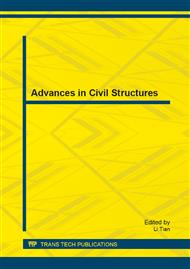[1]
Kosny. J, Christian J.E. Thermal evaluation of several configurations of insulation and structural materials for some metal stud walls. Energy and Buildings 1995; 22(3): 157-163.
DOI: 10.1016/0378-7788(94)00913-5
Google Scholar
[2]
Errera S.J. Tests of Wall Panels and Components for Mode 1Residential Steel Framing Systems. Bethlehem Steel Corporation, Report No. 72-7-3, Pennsylvania, U.S. A, (1974).
Google Scholar
[3]
Ife L.W. The performance of cold-formed steel products in housing. Proc. Of the 3rd Int. Conf. on Cold-Formed Steel Design and Constructions, St. Louis, Missouri, U.S. A, (1975).
Google Scholar
[4]
SBI StBK-N5-1979. Swedish Code for Light Gauge Metal Structures.
Google Scholar
[5]
Hőglund. T, Burstrand.H. Slotted steel studs to reduce thermal bridges in insulated walls. Thin-Walled Structures 1998; 32(1-3): 81-109.
DOI: 10.1016/s0263-8231(98)00028-7
Google Scholar
[6]
Salmi.P. Design of web-perforated steel wall studs. 4th Finnish Steel Structures R&D days, Lappeenranta, Finland, (1998).
Google Scholar
[7]
Kesti.J. Local and distortional buckling of perforated steel wall studs, PhD thesis. Helsinki University of Technology, Laboratory of Steel Structures, Espoo, (2000).
DOI: 10.1016/b978-008043015-7/50043-9
Google Scholar
[8]
Thőyrä.T. Strength of slotted steel studs. PhD thesis. Royal Institute of Technology, Stockholm, Sweden, (2001).
Google Scholar
[9]
Elhajj N.R. Development of cost-effective, energy-efficient steel framing. Final Report, AISI/DOE Technology Roadmap Program, Pittsburgh, PA, U.S. A, (2003).
DOI: 10.2172/807633
Google Scholar
[10]
Basharar. Behavior of cold-formed thin-walled steel studs with perforated web at ambient temperature and in fire, PhD thesis. Manchester University, (2007).
Google Scholar
[11]
Dinis. PB, Camotim.D. Local/distortional/global mode interaction in cold-formed steel rack-section columns, Proceedings of SSRC Annual Stability Conference (Orlando, 11-15/5), 481–504, (2010).
DOI: 10.1016/j.tws.2013.09.010
Google Scholar
[12]
Dinis. PB, Camotim.D. Local/distortional/global mode interaction in simply supported cold-formed steel lipped channel columns. International Journal of Structural Stability and Dynamics 2011; 11(5): 877–902.
DOI: 10.1142/s0219455411004385
Google Scholar
[13]
Dinis. PB, Camotim. D, Batista. E, Santos.E. Local/distortional/global mode coupling in fixed lipped channel columns: behaviour and strength. Advanced Steel Construction 2011; 7(4): 113–30.
DOI: 10.1016/j.compstruc.2010.11.015
Google Scholar
[14]
Eliane S. dos Santos, Eduardo M. Batista, Dinar Camotim. Experimental investigation concerning lipped channel columns undergoing local–distortional–global mode interaction. Thin-Walled Structures 2012; 54: 19–34.
DOI: 10.1016/j.tws.2012.02.004
Google Scholar
[15]
Pedro.B. Dinis, Batista. E, Camotim. D, Santos.E. Local–distortional–global interaction in lipped channel columns: Experimental results, numerical simulations and design considerations. Thin-Walled Structures, 2012; 61: 2-13.
DOI: 10.1016/j.tws.2012.04.012
Google Scholar
[16]
NAS. AISI Standard: North American Specification for the design of cold-formed steel structural members, American Iron and Steel Institute. (2007).
Google Scholar
[17]
AS/NZS 4600. Australian/New Zealand Standard. Cold-formed steel structures, Standards Australia, Sydney, (2005).
Google Scholar
[18]
ABAQUS, 6. 9 Documentation, http: /www. simulia. com.
Google Scholar
[19]
Schafer.B. W, Li. Z, Moen C.D. Computational modeling of cold-formed steel, Thin-Walled Structures 2010; 48(10-11): 752-762.
DOI: 10.1016/j.tws.2010.04.008
Google Scholar
[20]
ENV1993-1-3-2006, Design of steel Structures, (2006).
Google Scholar
[21]
Ellobody E, Young B. Behavior of cold-formed steel plain angle columns. Journal of Structural Engineering (ASCE) 2005; 131(3): 457–66.
DOI: 10.1061/(asce)0733-9445(2005)131:3(457)
Google Scholar
[22]
Cristopher.D. Moen, B.W. Schafer. Experiments on cold-formed steel columns with holes. Thin-Walled Structures 2008; 46(10): 1164-1182.
DOI: 10.1016/j.tws.2008.01.021
Google Scholar
[23]
Winter, G. Strength of thin-steel compression flanges. Trans ASCE 1947; 112: 527-554.
Google Scholar
[24]
B.W. Schafer, Review: The Direct Strength Method of cold-formed steel member design. Journal of Constructional Steel Research, 2008; 64(7-8): 766-778.
DOI: 10.1016/j.jcsr.2008.01.022
Google Scholar


